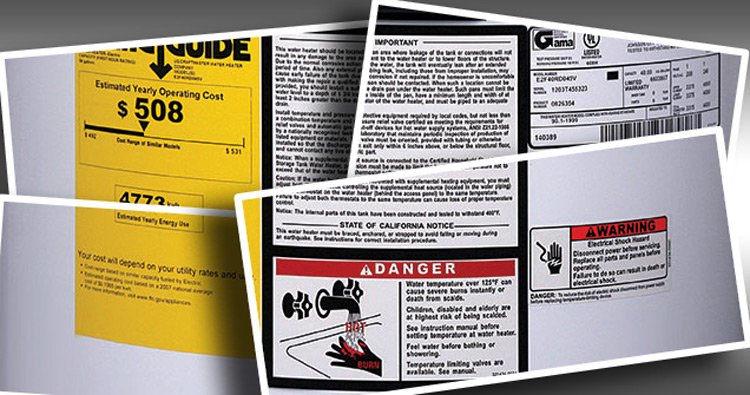If you have decided to install a water heater yourself to save money or to test your DIY plumbing skills, we suggest you may want to reconsider.
There are good reasons water heater installation accounts for a significant portion of the price of a new water heater, with safety and actual cost heading the list.
Safety First
We can’t emphasize the safety factor too much. If you make a mistake when you install a water heater it may be obvious right away, or it may take some time for the trouble to start. However, proper installation and regular maintenance will help prolong a water heater’s service life.
Eventually, all water heaters will fail. The first goal is to keep water heater failures from being spectacular, like the one in this video from the Mythbusters television show. It was launched like a rocket by pressure buildup, destroying concrete blocks beneath it and the roof above, showing that water heater explosions are real, not a myth.
For the demonstration, the temperature and pressure relief (TPR) valve was set to stay closed – as can happen in any home as a result of faulty installation or poor maintenance – which allowed more than 85,000 pounds of pressure to build up inside the tank before it blew.
The TPR valve’s job is to vent off excess pressure when water pressure is greater than 150 PSI or water temperature exceeds 210 degrees Fahrenheit. When the valve opens it discharges scalding hot water through the overflow tube.
The safety risk is obvious. Improper installation or a defective temperature and pressure relief (TPR) valve can result in a spectacular and devastating explosion. Add water damage to the structural repairs required and the cost can run into the tens of thousands of dollars.
The financial risk may be less obvious. Your homeowner’s insurance may cover water damage but that may be negated if the policy requires a licensed plumber to install a water heater, as many policies do.
Also, water heater warranties of many manufacturers will be voided if the installation is not done by a licensed plumber. Water heater manufacturers require the installing plumber’s license number to register the product warranty.
Skills, Knowledge, Tools, and Materials to Replace a Water Heater
Licensed plumbers are trained and equipped to ensure proper installation of water heaters of all types – gas, electric, tank and tankless, condensing, heat pump and geothermal. Their skills and knowledge encompass plumbing, electrical, carpentry, building codes and more. This diagram from coggle.it shows how all these (and more) come into play.

Also, licensed plumbers are insured so if they make a mistake the plumbing company is responsible, not the homeowner. If in doubt about whether a plumber is insured, ask to see proof of coverage.
Classic Errors to Avoid if You Install a Water Heater
We see the results all the time of amateur home handymen taking on the mother of all DIY plumbing projects when they decide to install a water heater themselves. In case you’re asking yourself, “What could possibly go wrong?” we have a sobering list for you.
1. Do You Really Need a New Water Heater?
If you’re confident enough to take on a project like this you probably feel equally confident your water heater is a lost cause. But wouldn’t it be a shame (and waste of money) if you made a bad diagnosis and decided to replace the water heater when the problem was a bad heating element or anode rod that could have been replaced? Licensed plumbers run diagnostics to determine the cause of the problem before recommending any action. The good ones will tell you if repairing or replacing is best.
2. Buying the Wrong Size
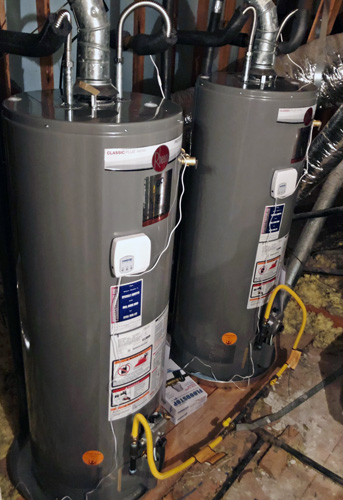 Size refers to tank capacity (gallons heated per minute for tankless water heaters) and dimensions of the heater itself. Let’s consider capacity first. Most homes with 2.5 baths and two to four residents will be well-served with a 50-gallon water heater.
Size refers to tank capacity (gallons heated per minute for tankless water heaters) and dimensions of the heater itself. Let’s consider capacity first. Most homes with 2.5 baths and two to four residents will be well-served with a 50-gallon water heater.
Depending on how much laundry you do and how many showers your family takes, a 60-gallon tank or larger may be required. Paying a little more for a bigger tank may save money over time, and almost certainly will save on needless frustration.
Bigger homes usually require bigger water heaters or more than one smaller one. We service many homes with three or more water heaters. For smaller homes where one or two people live a 30- or 40-gallon tank may be enough but be careful. If the tank is too small it will run all the time trying to keep up with demand and wear out faster than it should.
Increased government efficiency standards have resulted in a new generation of water heaters that are bigger and better. But keep in mind, like many of us, they’ve put on a few inches around the middle (top and bottom, too).
3. Water Heater Installed in a Prohibited Location…
You aren’t allowed to install a water heater anywhere you like. Most cities in the United States and other countries follow the International Code Council (ICC) models, which standardize residential and commercial building codes worldwide. In Texas, you must have a permit to replace or install a water heater and the installation must be inspected by your local municipality to ensure code compliance.
International Residential Code, Section M2005.2, addresses prohibited locations for gas and electric water heaters and supplemental heating devices and describes accessibility standards for water heater installation. For example, you may not install a water heater in a room used as a storage closet. Water heaters installed in a bedroom or bathroom must be “…installed in a sealed enclosure so that combustion air will not be taken from the living space.”
4. …or a Difficult Location
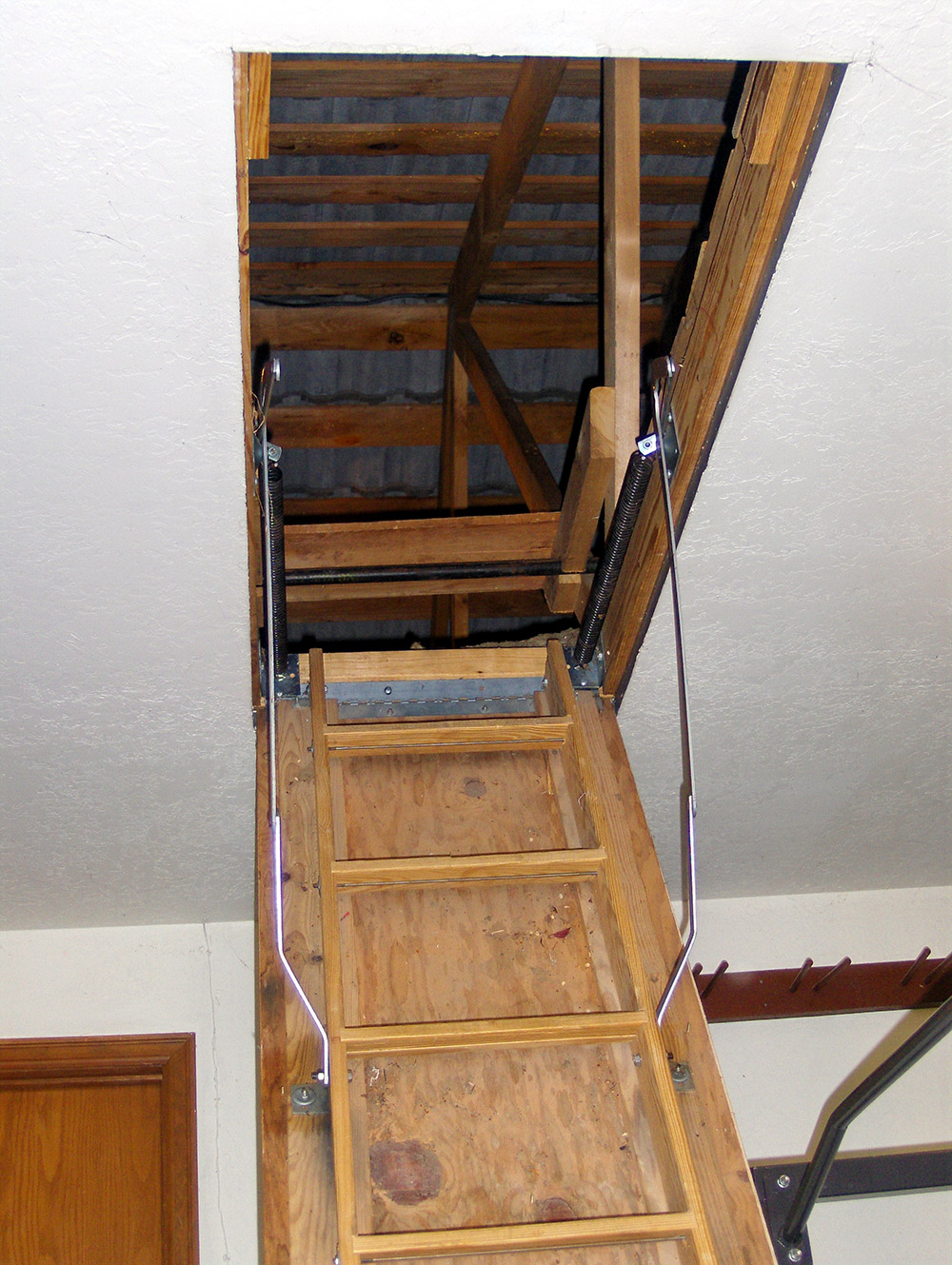 Section M1305 of the IRC specifies access requirements for water heaters and other appliances in locations including attics, rooms and under floors. Attic access, for example, must include an opening of at least 22” x 30” and a level service space for the water heater not less than 30” x 30”. There must be an unobstructed passageway of solid and continuous flooring at least 24” wide leading to the service space, which must be not more than 20 feet from the entrance.
Section M1305 of the IRC specifies access requirements for water heaters and other appliances in locations including attics, rooms and under floors. Attic access, for example, must include an opening of at least 22” x 30” and a level service space for the water heater not less than 30” x 30”. There must be an unobstructed passageway of solid and continuous flooring at least 24” wide leading to the service space, which must be not more than 20 feet from the entrance.
Many water heaters made since April 16, 2015, are taller and wider than previous models. Higher efficiency to meet new government standards includes better heat retention, which requires more insulation around the tank. That extra insulation can make a tight fit when you install a water heater in some locations.
Consider the popular Rheem Marathon plastic tank water heater. The model MR50238 high-efficiency, 50-gallon electric water heater is 23.5” wide – too wide for the 22” standard. A smaller model, a 40-gallon Model MR40245 is 21.62” wide, so if you’re extremely careful you can make it fit. But will you have enough hot water capacity?
If you have an older tank water heater in a location with limited space you may have to get creative to make a new one fit. Assuming you can get the tank through the opening, attic locations offer a lot of space to install a water heater of nearly any size but present another problem: getting the thing up to the attic.
A typical 50-gallon water heater weighs about 125 – 150 pounds, so this is not a one-person job. If access to the attic is via a pull-down ladder the lift will be a challenge for most people, and the combined weight of water heater and people may be more than the ladder can handle. Plumbers often must hoist up tank water heaters with a rope to work around this.
5. Installing a Water Heater without a Plumbing Permit
Permitting agencies can be pretty fussy about code enforcement. They like to send inspectors out to make sure the work was done right so it won’t create problems anytime in the future. The City of Grapevine, Texas, offers this document that spells out the types of work that require an owner, builder or contractor to obtain a permit.
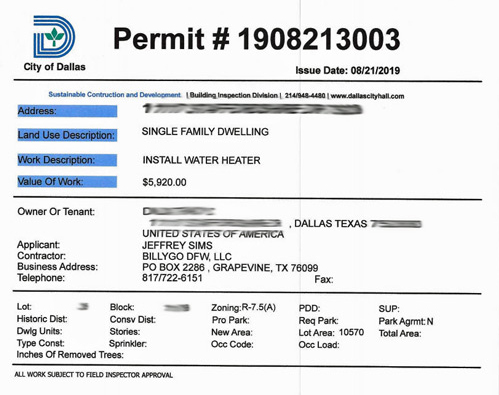 The Grapevine policy is similar to those of Dallas and other municipalities throughout Texas and in other states. Notice that some things – including specific mention of getting a permit to install a water heater– are covered by an exception. The document explains when a permit is not required (water leaks, clogged drains, etc.) but says removing and replacing plumbing requires a permit and an inspection following the work.
The Grapevine policy is similar to those of Dallas and other municipalities throughout Texas and in other states. Notice that some things – including specific mention of getting a permit to install a water heater– are covered by an exception. The document explains when a permit is not required (water leaks, clogged drains, etc.) but says removing and replacing plumbing requires a permit and an inspection following the work.
Many DIYers don’t want the expense and bother of pulling a permit, and – can you believe this? – some don’t get permits for home improvements because they don’t want their property taxes to go up. When the house is sold, the seller is required to disclose any work that was done that required a permit. Uh-oh. You could have legal problems with unpermitted work no matter how you answer that question. It’s also likely the unpermitted work will invalidate homeowner’s insurance coverage for any claims related to the work.
6. Failure to Purge Air from the Tank
Once you have the preliminaries out of the way it’s time to shut off the water supply to the water heater you’re replacing. You must drain the tank by attaching a hose long enough to reach a drain or to run outside the house. But before you do that, be sure to open a hot water faucet on an upper floor. This will prevent a vacuum from forming and allow air into the tank so it can drain completely.
7. No Drain Pan Under the Water Heater Tank
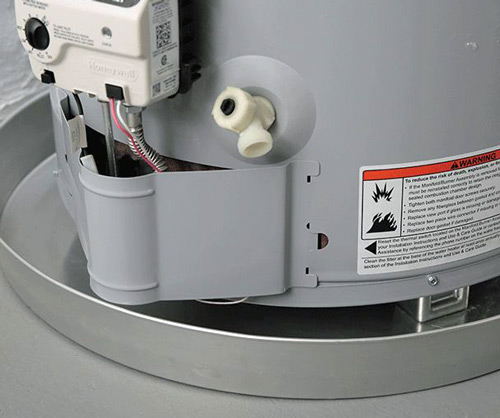 All residential tank water heaters in Texas must have a corrosion-resistant, waterproof drain pan, as described in this municipal code. The pan must be 1.5 – 2.5 inches high and two inches wider than the new water heater. It also must have a place to attach a drain pipe that runs outside the house and near the ground to discharge water if the tank fails.
All residential tank water heaters in Texas must have a corrosion-resistant, waterproof drain pan, as described in this municipal code. The pan must be 1.5 – 2.5 inches high and two inches wider than the new water heater. It also must have a place to attach a drain pipe that runs outside the house and near the ground to discharge water if the tank fails.
If the old drain pan is large enough you may be able to use it, but inspect carefully for damage or corrosion. Depending on the water heater’s location, drain pans can be damaged by things falling on them or being stored against them. If a tank lets go in your attic, whether it’s 40 gallons or 100, that’s a lot of water running into the drain pan in a hurry. If the drain line is too small or obstructed it won’t be able to handle the flow you will have water damage.
8. Water Heater Power and Gas Shutoffs Not in Sight
Whether you install a water heater that uses gas or electricity, no heat must be applied until the heater is fully installed and filled with water. Applying heat to an empty tank is called dry firing, which is not what you want to do. Heating elements in electric water heaters must be immersed in water or they will overheat and burn out quickly. Flame applied to an empty gas water heater can overheat the tank and crack it.
To ensure power remains off you must be able to see the shutoff switch from where the hot water heater is located. If the heater is plugged into a receptacle near the water heater or if the circuit breaker is in sight, that’s all you need. If not, you need a lock on the breaker box or a separate electrical disconnect switch, breaker or pull-disconnect box near the water heater.
9. TPR Valve and Discharge Tube Errors
As we’ve already discussed, when you install a water heater you must be certain the TPR valve is working and that any hot water it expels is routed through the discharge tube. You should expect the TPR valve to open and discharge water from time to time. That water must go either to an overflow tank or to a drain. Some municipalities require overflow tanks and some don’t so know the local code requirements.
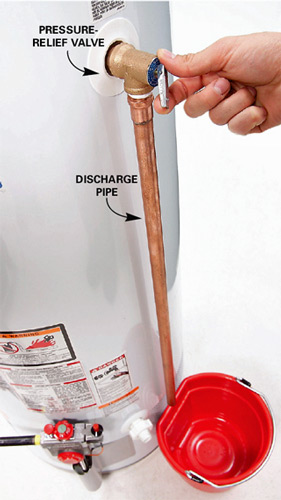 There are code standards for discharge tube materials and installation that most DIY plumbers don’t know about. You’ll never go wrong with the copper pipe, as shown in this image from the home inspection professionals’ site, nachi.com. Common discharge tube errors DIYer plumbers make include:
There are code standards for discharge tube materials and installation that most DIY plumbers don’t know about. You’ll never go wrong with the copper pipe, as shown in this image from the home inspection professionals’ site, nachi.com. Common discharge tube errors DIYer plumbers make include:
- Discharge tube too short – it must extend to within 6” of the floor or a drain pan, to keep scalding hot water from spraying on anyone or anything nearby. The bottom must not be threaded.
- Made of unapproved material – approved materials include copper, galvanized steel, CPVC, stainless steel or polypropylene. Non-approved plastics can melt.
- Tube diameter too small – the discharge tube cannot be smaller than the TPR valve it connects to, which usually is ¾”. Also, there must be no step-down in tube size below the connection to the TPR valve.
- Improper routing of discharge water – the water must go from the discharge tube to a floor drain, an indirect waste receptor (drain pan) or routed through a line that leads outside the house. It must not be connected directly to the drainage system because backflow could contaminate the hot water supply. It should be obvious, but the discharge tube must never be capped.
This is a shortlist of common discharge tube errors. This article by InterNACHI, the International Association of Certified Home Inspectors provides more complete guidance.
10. Poor Soldering Technique
You don’t have to know how to sweat a soldered joint to install a water heater, but that’s the preferred way. This includes knowing how to use a pipe cutter and remove burrs from the cut ends, flux the joints and apply heat evenly. You must hold the torch in the right place to allow the melted solder to flow into the joint and form a water-tight connection.
The skill is one nearly anyone can acquire, with practice, but which too many amateur plumbers never seem to learn. As a result, they fail to consider the unwanted effects of the heat from the torch. Heat applied to copper tubing travels through the copper. If a soldered connection is made too close to the top of the water heater the heat traveling through the copper pipe can melt the dip tube or other plastic parts.
When experienced plumbers install a water heater, they disconnect the nipples from the tops of the tanks and make all but the final solder connection while the copper lines are disconnected. When setting up the final soldered connection it should be as far from the tank as possible, about a foot or so. Wrapping a cold, wet rag around the copper pipe will help keep it cool.
11. Materials Choice
DIY plumbers who want to avoid soldering usually opt for PEX plastic tubing with pop-on or push-fit connectors because they seem easier to install. PEX is flexible, so it is easier to route around corners and other structures. But its flexibility can be a liability.

Because it is not rigid, PEX tubing will flex like a garden hose when water flow starts and stops. It also expands and contracts with temperature changes, which causes the PEX line to move back and forth. This can cause wear anywhere the PEX line comes in contact with any hard surface. PEX must be protected and supported at corners and where it passes through structure using abrasion clips, pipe insulation or some other approved protective material. Putting too sharp a bend in PEX can cause it to kink like a garden hose.
The “easy” connection process is far from fool-proof, too. It can be quite difficult to get the plastic tubing aligned perfectly with the connector so it will maintain a tight connection as water flow stops and starts. When a good connection is established it is harder to undo for repairs than copper connections. Also, unlike copper, PEX also is especially vulnerable to UV rays and rodent damage.
12. Mixing Metals
Mixing metals when you install a water heater can result in serious corrosion, depending on the precautions you take. Galvanic corrosion is the result of metals of different types physically touching or being connected by electric contact while immersed in an electrolyte. Water is an electrolyte, so water heater tanks have sacrificial anode rods designed to make them corrode instead of the tank or other metal parts.
Galvanic corrosion also can occur when connecting two plumbing pipes made of different metals, such as copper and galvanized steel. If the water supply and distribution lines for a water heater are copper but the water heater has galvanized steel nipples (plumbing connection points on top) corrosion will result. DIY plumbers who aren’t aware of the need to use insulated, dielectric connectors set themselves up for certain corrosion and are in violation of building codes.
13. Failure to Secure Water Heater and Power/Gas Supply
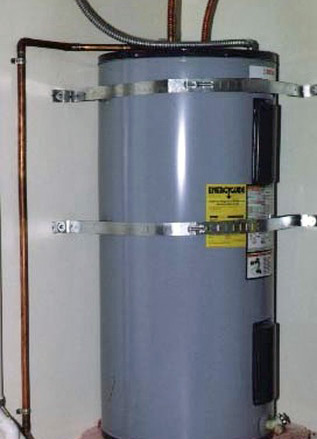 If placed in a location where it could be bumped, strap the tank down or otherwise secure it. A bump may not tip over a heater full of water, but it can loosen fittings and cause leaks to develop. People who install a water heater in areas of seismic activity are required to secure it with seismic straps.
If placed in a location where it could be bumped, strap the tank down or otherwise secure it. A bump may not tip over a heater full of water, but it can loosen fittings and cause leaks to develop. People who install a water heater in areas of seismic activity are required to secure it with seismic straps.
Water heaters in garages must be protected by wheel stops/curbing, bollocks or other structures to prevent vehicles from hitting them.
Gas and electric lines also must be fastened in place. It’s bad enough to trip on a gas line in a dark attic but even worse if you loosen a connection and cause a gas leak. Use conduit to protect electrical lines. Although not required in attics, it’s a good idea to secure the electric lines inside conduit in areas where there is foot traffic. Electrical wiring throughout the circuit must be the right gauge to handle the demands of the water heater.
14. Vacuum Breakers and Automatic Shutoffs
Plumbing code requires vacuum relief valves on bottom-fed tank water heaters to prevent a back-siphon from the tank in case of suddenly reduced pressure in the water supply. This can happen when fire crews flush hydrants or when a water line is cut. The same danger exists in homes with well water if the water pump fails. The vacuum breaker lets air in to break the siphon.
If the tank is drained dry firing can occur, damaging a gas water heater tank or burning out heating elements in electric water heaters.
Automatic shutoff valves should be installed in case a water heater leaks and the drain pan cannot drain. If the tank fails and drains rapidly two things can happen: 1) the water continues to pass through the tank into the overflow tray until it spills over the top, and 2) the empty tank will overheat and be damaged. The shutoff valve should be installed to shut off power and water.
15. Improper Venting
 Proper venting of gas water heaters is essential for the safety of everyone in your home. When vented correctly, a natural draft draws combustion gasses up the flu and discharges them into the air outside. The flue pipe should have a slight pitch of ¼-inch per linear foot, as shown in this illustration by InspectApedia.com. This assures carbon monoxide and other toxic gasses are vented to the outside and can’t build up in the house.
Proper venting of gas water heaters is essential for the safety of everyone in your home. When vented correctly, a natural draft draws combustion gasses up the flu and discharges them into the air outside. The flue pipe should have a slight pitch of ¼-inch per linear foot, as shown in this illustration by InspectApedia.com. This assures carbon monoxide and other toxic gasses are vented to the outside and can’t build up in the house.
You can check for back-drafting in the flu by using a smoke wand or by striking a match near the vent hood at the top of the water heater. If the smoke is not drawn up the vent something is badly wrong. Get a licensed plumber to fix it.
Also, make certain gas water heaters have clearance from walls and stored objects to allow good airflow for combustion and to keep the heater a safe distance from combustible materials. The International Residential Code, Section M1306 prescribes clearance distances in locations in finished and unfinished spaces, as will the water heater manufacturer’s installation instructions.
Other Considerations Before You Buy and Install a Water Heater
Licensed plumbing professionals sell professional-grade water heaters, compared to consumer-grade products offered to the public at big box stores. There is nothing wrong with consumer-grade products, but you should be aware of the differences, including installation, service, parts, and warranties so you can make an informed decision. Here’s a comparison of comparable Rheem professional-grade and consumer-grade products.
| Professional Grade | Consumer Grade |
| Brass drain valve | Plastic drain valve |
| Metal body gas valve | Plastic body gas valve |
| Uses traditional thermocouple to control gas flow) | Uses thermopile variant, which has been less reliable |
| Available upgrade to the additional anode rod | No upgrade available |
| Longer-lasting stainless-steel heating elements in electric water heaters | Shorter-lived copper heating elements in electric water heaters |
| Rheem dealer honors warranty, which covers all parts, tank and labor. Work performed by an employee of the selling dealer. | Rheem dealers do not honor the warranty. Warranty work must go through contractors retained by the selling big box company. These contractors are not well-compensated, so you get less-skilled technicians and you may have to wait several days for service. |
| Installation included in the sale price of the heater | Installation is an extra cost, and often is low-balled; you may end up paying more when the heater is installed. |
| Genuine replacement parts available through Rheem dealer | Replacement parts must be purchased through selling big box company |
So, ask yourself if you really save money when you go to a big box store to buy and then install a water heater yourself. It may surprise you to know it often ends up costing you more.
CONCLUSION
Installing a water heater is no average DIY project. You must have plumbing, electrical, heating ventilating, and carpentry skills, know state and local building codes, obtain a permit for the work and arrange with your municipality for an inspection of the work.
Failure to comply with plumbing codes can put you at substantial physical, financial and legal risk. When you have a licensed plumber install a water heater the plumbing company assumes the risk and has insurance to cover it. If you perform unpermitted work, you place yourself in legal jeopardy and may invalidate homeowner’s insurance coverage related to the work.
All water heaters fail eventually, but you can help avoid spectacular failures by hiring a licensed plumber instead of doing it yourself. You will avoid the 15 common mistakes DIY plumbers make when they install a water heater, get a higher quality water heater, and most likely save money in the long run.
If you need help getting a new water heater installed in your Dallas-Fort Worth home, we have plumbers experienced with installing tankless and traditional tank water heaters standing by.


